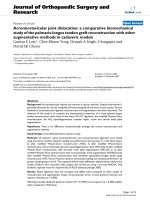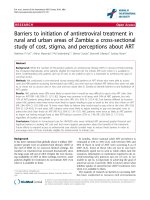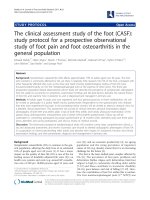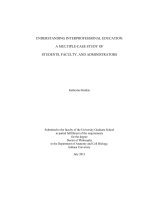A comparative acoustic study of Hanoi Vietnamese and general American English monophthongs
Bạn đang xem bản rút gọn của tài liệu. Xem và tải ngay bản đầy đủ của tài liệu tại đây (127.58 KB, 3 trang )
A comparative acoustic study of Hanoi Vietnamese
and general American English monophthongs
Doãn Minh Mão
Trường Đại học Ngoại ngữ
Luận văn Thạc sĩ ngành: English Linguistics; Mã số: 60 22 15
Người hướng dẫn: M.A. Phạm Xuân Thọ
Năm bảo vệ: 2012
Abstract. The first purpose of the current study was to give an acoustic description of the pure
vowels in Vietnamese, Hanoi dialect. Recordings were made of ten female speakers of the
dialect, producing the vowels /i/, /e/, /ɛ/, /ɛ
̆
/, /ɯ/, /u/, /o/, /ɔ/, /ɔ
̆
/, /ɤ/, /ɤ
̆
/, /a/, and /ă/. Formant
contours F1-F2 were measured with the built-in formant tracker of PRAAT, from the LPC
spectra, and from the spectrograms. The findings supported some important proposals of the
vowel qualities made by traditional description methods in literature, especially the claim that
duration is a distinguishing feature of many vowels. However, it has also gone against previous
arguments at some points. The research also set out to draw a comparison between the relative
positions of the pure vowels in Vietnamese and General American English on the formant
charts. The findings show that, aside from the differences, in many positions on the vowel
charts there are vowels in both languages, despite the different phonetic symbols with which
they are represented.
Keywords. Âm vị học; Tiếng Việt Hà Nội; Tiếng Anh Mỹ; Nguyên âm
Content
1. Rationales
The ultimate aim of this research is to achieve a cross language comparison between the acoustic
properties of Hanoi Vietnamese monophthongs and General American English monophthongs.
The findings of the accomplished study are significant, from both the linguistic and pedagogical
perspectives.
Ladefoged states firmly that, “The best way of describing vowels is not in terms of the
articulations involved, but in terms of their acoustic properties.” (2003, p.104). A considerable
amount of space of this thesis is devoted to the researcher’s analysis of the monophthongs, or pure
vowels (Wells, 1962, p.1) of Vietnamese, Hanoi dialect. Aside from a few studies conducted
overseas, which have important limitations to be addressed, which are discussed in details in the
Review of Literature of this thesis, there has been no attempt to study the vowel acoustics of the
recognized standard Vietnamese so far.
The literature on Vietnamese vowel acoustics has been mainly concerned with the description of
the sounds from the views of articulatory phonetics. The investigations conducted by Nguyễn
(1998), and Đoàn (2000) are typical examples. These studies examined the behaviors of the vocal
organs involved in the articulatory process when a particular sound is being produced. This
method, while having the advantage of being straightforward, has put forwards ideas which
remain an approximation to the truth. Ladefoged and Johnson (2011, p.197) comment,
Traditional articulatory descriptions are often not in accord with the actual articulatory facts. For
well a hundred years, phoneticians have been describing vowels in terms such as high versus low
and front versus back. To some extent, they have been using these terms as labels to specify
acoustic dimensions rather than as descriptions of actual tongue positions. Phoneticians are
thinking in terms of acoustic fact, and using physiological fantasy to express the idea.
Acoustics offers sufficient tools for explaining the vowel qualities. The production of a speech
sound involves firstly the vibration of the vocal cords, which produces sound waves. It involves
secondly the performance of the vocal tract, which can be changed into various shapes, as a filter,
under the acoustic impedance. Vowel sounds are characterized acoustically by formants, which
are frequency regions of high energy concentration corresponding to the pass bands of the throat
and mouth cavities (Wells, 1962, p.1).Therefore, instead of only studying a particular sound from
the outside, rather subjectively, by observing with eyes, trying to set up a collection of its
articulatory features, there should be a rigorous description method where every dimension of a
sound as its nature is measured and displayed objectively on the screen of an electronic device.
The analysis, carrying out appropriately, would result in an acoustic vowel chart, representing
accurately the linguistic aspects of Hanoi Vietnamese monophthongs, which serves as a valuable
source of reference for cross language comparison.
The pronunciation of General American English and of Hanoi Vietnamese are acknowledged as
the reference accents of English and Vietnamese respectively. As a result, from the pedagogical
aspect, the findings of the research are of highly practical values in teaching the pronunciation of
one language to learners of the other language.
2. Scope of the research and the research questions
The study first examined the quality of the pure vowels in Hanoi Vietnamese. The frequencies of
each of the first two formants of each monophthong (F1, F2) were investigated on the acoustic
spectrographs, generated from the speech analyzer program PRAAT.
The results obtained from the analysis were then compared with the results of a recent research in
the monophthongs of General American English, conducted by Clark, M. J, Hillenbrand, J, et al.
(1995).
The research is aimed at answering two questions:
1) What are the acoustic properties characterizing Hanoi Vietnamese monophthongs?
2) What are the common and distinctive features between the relative positions of the
monophthongs in Vietnamese and General American English on the formant charts?
References
Billerey, J. (2001). JPlotFormants v1.4: Formant-plotting software. Retrieved from
Clark, M. J, Hillenbrand, J, et al (1995). Acoustic characteristics of American English vowels.
Journal of Acoustical Society of America. 97(5).
Đoàn, T. T. (2000). Ngữ âm Tiếng Việt. Hà Nội: Nhà xuất bản Đại học Quốc gia Hà Nội.
Gimson, A.C (2008). Pronunciation of English. Oxford: Oxford University Press.
Gomez, E.T. (2012). British and American English Pronunciation Differences. Retrieved from
Johnson, K. (2005). Speaker normalization in speech perception. Retrieved from
Johnson, K., Ladefoged, P. & Lindau, M. (1993) Individual differences in vowel production.
Journal of Acoustical Society of America. 94, 701-714.
Ladefodged, P & Johnson, K. (2011). A Course in Phonetics. Boston: Wadsworth.
Ladefoged, P. (2003). Phonetic Data Analysis: An Introduction to Fieldwork and Instrumental
Techniques. Oxford: Blackwell Publishing.
Ladefoged, P. (2005). Vowels and Consonants. Oxford: Blackwell Publishing.
Ladefoged, P. (1996). Elements of Acoustic Phonetics. Chicago: University of Chicago Press.
Lindau, M. (1978). Vowel features. Language, 54(3), 541 -563.
Matt, W et al. (2009). Vietnamese Vowel, the Central Focus. Retrieved from
.
Mai, N. C, Vu, D.N. & Hoang, T.P (2008). Cơ sở ngôn ngữ học và Tiếng Việt. Hà Nội: Nhà xuất
bản Giao dục Việt Nam.
Nguyen, B & Srihari, R. (2004). A preliminary quantitative study on the characteristics of
Vietnamese vowels and English vowels. Retrieved from
Pham, A. (2003). Vietnamese tone: A new analysis . Outstanding Dissertations in Linguistics.
New York: Routledge.
Shure Americas (2012). PG27USB Spec Sheet. Achieved from
Thompson, L.C. (1965). A Vietnamese Reference Grammar. Hawaii: University of Hawaii Press.
Thompson, L.C. (1987). A Vietnamese Reference Grammar. Hawaii: University of Hawaii Press.
Wells, J.C. (1982). Accents of English. Cambridge: Cambridge University Press.
Wells, J.C (1962). A study of the formants of the pure vowels of British English (MA Thesis). Retrieved
from
Weenink, D. & Boersma, P. (2012). Praat: doing phonetics by computer. Retrieved from









